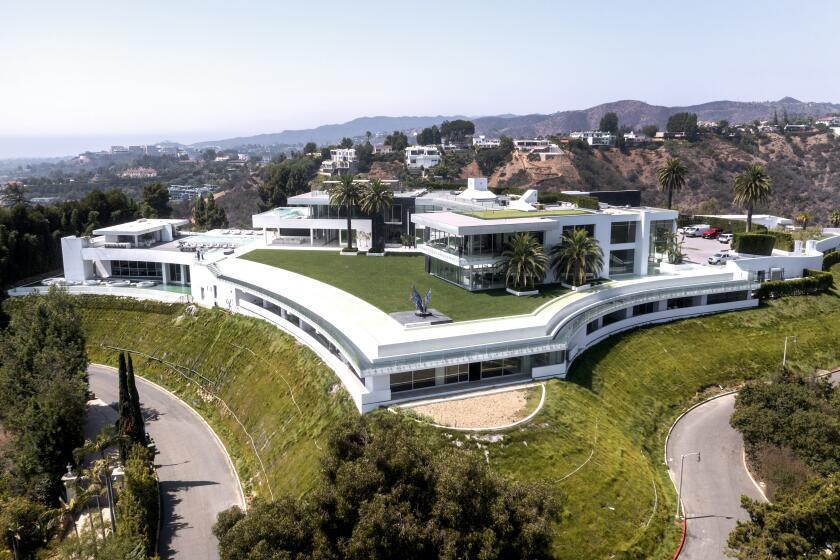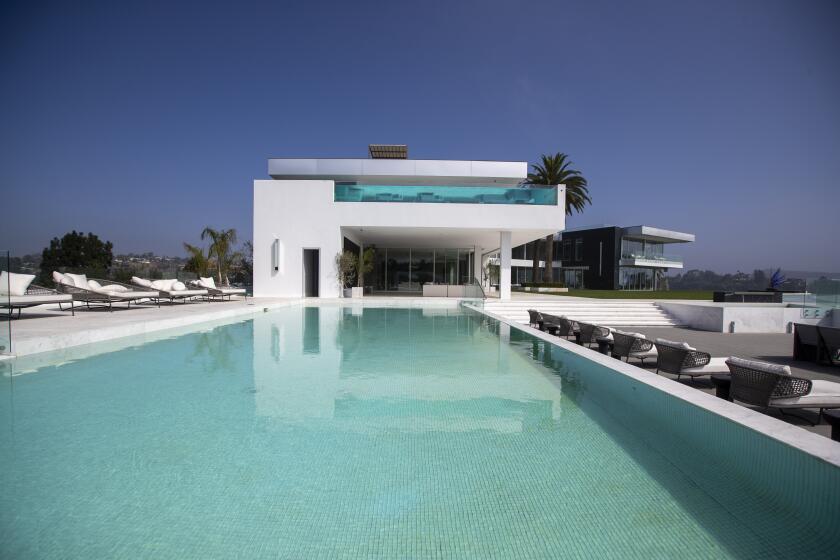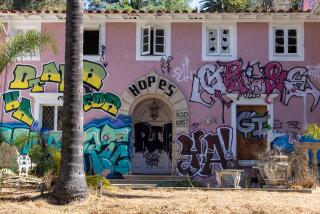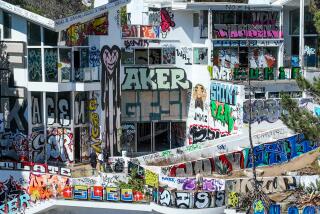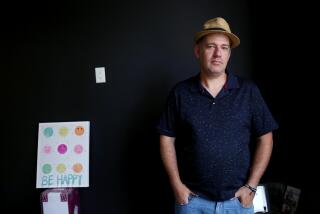Fight over ‘The One’ mega-mansion heads to Bankruptcy Court

- Share via
“The One” mega-mansion was pulled Wednesday from the auction block, one day after the developer’s limited liability company filed for Chapter 11 bankruptcy protection to stop the sale.
The 105,000-square-foot Bel-Air mansion was set to go to the highest bidder at a trustee’s sale outside Los Angeles County Superior Court in Pomona after developer Nile Niami’s Crestlloyd defaulted on $106 million in debt owed to Hankey Capital, Los Angeles billionaire Don Hankey’s real estate lending business.
Crestlloyd was placed into bankruptcy protection Tuesday afternoon in what proved to be a successful last-minute bid to block the foreclosure sale, moving — at least temporarily — a high-stakes fight between the developer and multiple feuding lenders to U.S. Bankruptcy Court in Los Angeles.
The disposition of the largest modern home in the country — once marketed for $500 million and the magnum opus of Niami, dubbed the king of the L.A. mega-mansion — now goes before Bankruptcy Judge Deborah Saltzman, a 12-year-veteran of the bench.
The idea was simple: Nile Niami would build and sell The One, the biggest and most extravagant new home in the country. Then things went sideways.
Lawrence Perkins, appointed manager of Crestlloyd this week, said the focus will be on completing the home, marketing it and ensuring it is seen by prospective high-level buyers — including one who ultimately purchases it.
The mansion at 944 Airole Way features ultra-luxury amenities such as multiple pools; a spa; a beauty salon with washing, cutting and pedicure stations; cigar and candy rooms; a four-lane bowling alley; a rooftop putting green; and a multiplex-size movie theater.
“This isn’t just a regular home to sell, so there’s certain steps you need to take to be able to deal with a home like this,” said Perkins, chief executive of turnaround specialist SierraConstellation Partners. “It starts with money, and working out a deal to be able to execute [all] that is probably the top priority right now.”
He said the plan will be laid out in detail in the coming weeks in Bankruptcy Court, where Hankey could seek to have the process halted. The trustee’s sale was postponed until Nov. 29.
The goal is to get the highest sale price for the house while maximizing the proceeds to the creditors, which include not only Hankey but also other secured construction lenders who are owed tens of millions of dollars, as well as unsecured creditors such as vendors and contractors.
Developer Nile Niami’s Crestlloyd LLC filed for Chapter 11 on Tuesday, one day before a trustee’s sale of the mega-mansion had been scheduled.
Attorney John Tedford, a partner at Danning Gill in Los Angeles who worked for a client involved in another foreclosure dispute with Hankey Capital, said the bankruptcy case was unusual because it involved a single-family residential property with a value more typical of commercial real estate.
That means the effort to persuade the judge to keep the case in Chapter 11 and not allow the foreclosure sale to proceed will focus on convincing her that there is adequate value in the property to ensure Hankey Capital is repaid what it is owed.
“If the property is worth less than Hankey Capital is owed, the judge is more likely to allow Hankey to proceed with its foreclosure,” he said. “It becomes a battle of experts — Crestlloyd’s appraiser versus Hankey Capital’s appraiser — with the judge somehow having to decide how much this unique property is worth.”
If Crestlloyd makes interest payments on Hankey’s debt — which it may or may not be required to do — that also would be a factor in the judge‘s decision, he said.
Perkins said it’s Crestlloyd’s belief there is a “lot of value” in the house and said his firm would try to work with Hankey to sell the house in a bankruptcy proceeding.
Crestlloyd, in bankruptcy filings, values the home at $325 million and says it carries a total of $180 million in debt, including $176 million that is allegedly secured — enough to pay creditors even if the house is sold for less.
Hankey has not returned The Times’ emails seeking comment. However, he told Bloomberg News that he was “disappointed” with the bankruptcy filing.
“All we want is to get our capital returned,” said Hankey, who made his fortune in subprime auto lending and operates seven businesses through his Hankey Group.
Wednesday’s postponement marked the third time the trustee’s sale was put off. A July date was delayed until Oct. 13 by Hankey, who decided to put the house into the hands of a receiver tasked with completing it and marketing it for sale. The plan had the support of Niami, as well as other lenders who committed millions to the project.
Just this month, the court approved a deal with two brokers to list the home for $225 million.
However, Hankey decided to push ahead with the Oct. 13 auction, prompting lender Joseph Englanoff’s Yogi Securities Holdings to seek a temporary restraining order to block it. Yogi lent Crestlloyd $30.2 million in 2018 and is still owed $22 million, according to a declaration that Englanhoff filed in support of that case.
Englanoff, a Los Angeles-area physician and longtime investor in Niami’s developments, accused Hankey of trying to take ownership of the mansion at a rock-bottom price by buying it himself at the auction, or take all of the proceeds if it was sold to a third party.
Superior Court Judge Mitchell Beckloff did not issue the temporary restraining order but delayed the auction until Oct. 27 to give the two sides time to work out a deal.
Hankey previously told The Times that he had tried but failed to come to an agreement with Englanoff. At a separate Superior Court hearing Tuesday called by the receiver, attorneys for Hankey and Yogi did not indicate any deal had been worked out.
The mansion’s other major secured debt holder is an entity called Inferno Investment, associated with Julien Remillard, a longtime friend of Niami, which lent Crestlloyd more than $10 million in 2015 but worked out a deal with Hankey to be paid second out of the sale proceeds.
An attorney for Remillard declined Wednesday to comment on the bankruptcy action.
There are also several million dollars in unsecured debt attached to the property to contractors and others, according to the bankruptcy filing.
That includes $750,000 owed to Creative Art Partners, which provided the house with art — and whose debt is disputed by Crestlloyd — and $275,705 to Vesta, which staged it with furniture and accessories. An additional $400,000 is owed to Branden Williams, an earlier listing agent on the house, according to the filing.
A crucial question now will be how long would it take to finish the house and complete any necessary repairs. The home does not have a certificate of occupancy from the city of Los Angeles, which means it cannot be lived in.
This is not the first time that Niami has run into trouble with his spec homes, which are built without a particular buyer in mind. Nor is it the first Niami home placed into bankruptcy.
He was one of the most successful developers of L.A. mega-mansions before competition arose from other spec builders. Sales slowed and this year he unloaded several homes under their initial asking price.
In the spring, after Niami defaulted on his debt to Hankey, he proposed living in The One and turning it into an event space featuring entertainment such as boxing matches and concerts. Hankey turned down the plan.
In Bel-Air, a 30,000-square-foot mega-mansion from architect Paul McLean and developer Nile Niami is asking a whopping $65 million.
More to Read
Inside the business of entertainment
The Wide Shot brings you news, analysis and insights on everything from streaming wars to production — and what it all means for the future.
You may occasionally receive promotional content from the Los Angeles Times.
